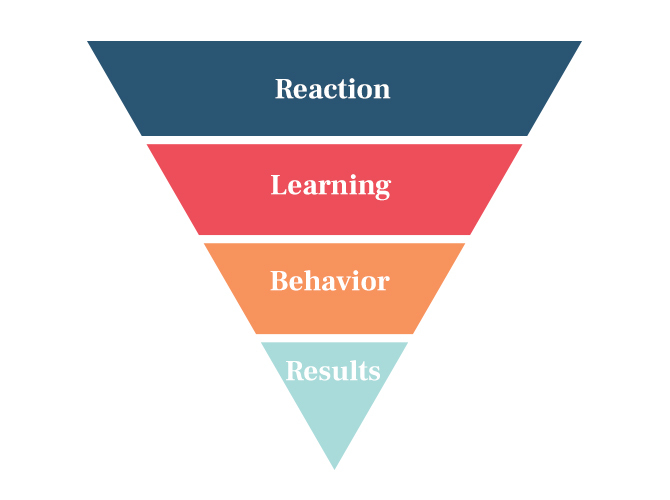
It’s been 60 years now since Donald Kirkpatrick presented his concept of four-level evaluation of training and its impact on organizational development, published by Journal of American Society of Training Directors. And yet, companies still find it difficult to assess the profitability of development programs. After all those years, the New Kirkpatrick Model ® is here to show us where we were wrong.
The subject of training effectiveness usually meets with two kinds of reactions. Some people respond to it with a skeptical or surprised smile. Others feel awkward or even scared. The former are usually managers, while the latter are coaches or persons responsible for L&D programs in organizations. Data confirms that: 20% of companies do not verify the outcomes of the courses for employees they organize. The impact of training is often considered too difficult to be measured. The New Kirkpatrick Model® proves that this is not only possible but also pretty easy. You simply need to start from the end.
An imperfect model
In the traditional model developed by Donald Kirkpatrick, evaluation was carried out on the basis of four levels: reaction, learning, behavior, and results. The first level checked the participants’ satisfaction with the training and the second one monitored what they learned. The other two defined correlation between the acquired skills and the employees’ behavior at work as well as their impact on business. They were meant to do that. However, in practice, the evaluation process usually stops after the first two levels. The last two usually seem too hard and unviable. L&D departments frequently admit that running surveys, which analyze only the participants’ satisfaction and knowledge, is the easiest way of gathering feedback. This is where their role ends. Precise calculations of ROI take a number of variables into account, not only the training as such. The conclusion is clear – it’s time to change the starting point.
Change management instead of evaluation
The New Kirkpatrick Model® is based on the assumption that training programs – or at least some of them – have a real impact on change management in organizations. It is not just about the evaluation but also about shifting the center of focus from the end to the beginning of the whole process. Training is not only supposed to support the process of change. It is also an integral element of change. In fact, this approach is not so much different from the traditional model. Actually, it expands it. What does the New Kirkpatrick Model® consist of?
Stepping out of the comfort zone – The New Kirkpatrick Model® and its assumptions
The new approach, developed by Jim and Wendy Kirkpatrick (Donald’s son and daughter-in-law), was adjusted to the needs of modern businesses, oriented toward financial results rather than training evaluation. This is a challenge for trainers, as they need to leave the training classrooms and cooperate with the clients directly. A training program does not begin at the stage of preparing a course but from the description of expected results (level IV) implemented through behavior change (level III). Only then one can choose the suitable tools. Thus, an effective process takes place in reverse order as compared to the traditional model. This is not all, though. Jim and Wendy expanded the scope of particular evaluation levels as well.

The new four levels of training evaluation
- Level I – apart from measuring the employee satisfaction, it also includes the adaptation of training to the requirements of a particular job. Participants assess if and to what extent they are able to put the acquired knowledge into practice. What’s more, this stage takes the participants’ personal responsibilities into consideration, as well as their involvement in the process of change.
- Level II evolves from a knowledge test to a skills test. Its goal is also to evaluate the attitude change potential – do participants actually want to use the new skills in practice, what are their motivation and self-confidence levels?
- Level III defines the so-called critical behavior. At this stage, the knowledge and skills gained as part of the training are implemented and used by employees in their daily work. When establishing the factors, it’s a good idea to identify key behaviors that the employer is going to monitor, support, and reward.
- Level IV shows the results which are checked by means of lead indicators. At this stage, employees talk to managers, who are responsible for supporting and reinforcing their behaviors. This is the point where the compatibility of expectations and training results is verified. Moreover, the process of change implementation is continued.
All four levels focus on employees. After all, the process is not about the training program. It is about a real change in employees’ behavior, which should influence the strategic areas for the company’s development. This is the crucial change in the new model, apart from the reversal of the order of evaluation.
Did you know that you could use the New Kirkpatrick Model to measure the effectiveness of onboarding too?
Learn how
A recipe for an effective training
All courses run in an organization have their objectives – but they are not always strategic objectives for the company. Most of them should bring tangible profits and these are the ones that should be evaluated using the New Kirkpatrick Model®. Particular components of L&D programs are of great importance here: from the analysis of training needs, to the preparation of the program, to its implementation and evaluation. However, if your goal is a lasting transformation, you cannot stop at the final stage. Effective learning goes far beyond the classroom. Research shows that courses as such constitute a mere 10% of the whole process. Up to 70% is on-the-job learning, and 20% is learning from others. In this approach, the implementation of a training program should not be run by L&D departments only. It needs to become an interdisciplinary project, based on partnership focused on a common goal.

The use of clear, transparent, and – above all – effective methods of training evaluation has a solid benefit: it increases the reliability and prestige of training projects in your organization by proving that they can be directly translated into financial results. Besides, training evaluation doesn’t have to be a painstaking and complicated process. L&D departments need to learn how to prove their value to business. The New Kirkpatrick Model® can be a great tool to take your first step toward that goal.

